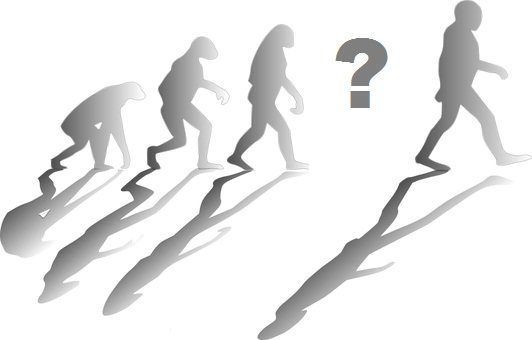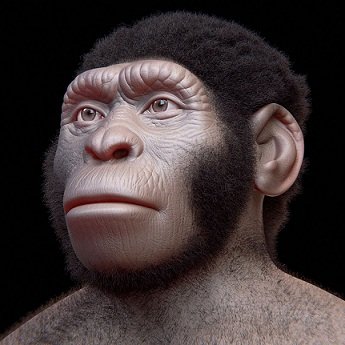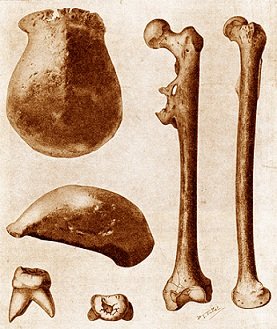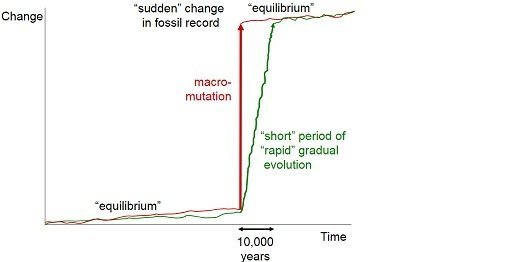Why Are There So Many Missing Links In Human Evolution? [Concept Of The Transitional Fossils]
Introduction
Have we actually been able to trace the timeline of human evolution from the earliest hominid species down to the extant Homo sapiens correctly?. This question has been popping up in my mind, and I know you may have; at some point; had the same thoughts too. In this survey, we will be looking at the concept of transitional fossils to help us understand the overall timeline of human evolution. Welcome to the past, lol.
[Image Source: Pixabay. CC0 licensed. Edited by me]
No doubt, evolution; just as you know; has been based majorly on the study of evidences presented from fossils, and through the paleoanthropological analysis of these fossils, we can chart; to a considerably fair extent; the trail of evolution of humans. But this is not as easy and straightforward as it sounds - more like coupling up tiny pieces of a map while at the middle of a journey. For example: If you were asked to provide the name of your great-grandfather, you may probably have an answer to that; but if someone asks you "what specie evolved into the "Cro-Magnon man?", it wouldn't be an easy answer to provide. The truth is; none of us lived through these evolutionary processes, so we are heavily reliant on archeology (but for the later part of it; "written record" and "oral tradition" could suffice). But as it were, these fossils are spread throughout the earth - I mean, the earlier men weren't only located at Olduvai Gorge where the fossils of the Zinjanthropus were discovered [ref]. So to accurately trace the exact trail of evolution, every single location on earth would have to be excavated in search of matching fossils (which is almost an impossible task to accomplish), so by reason of these; there have been some perceived gaps in the trail of evolution; and these gaps has been termed by many as "Missing links". This is just looking at a part of evolution; but considering the fact that these complex life form in this present time (including the Homo sapiens) have evolved from much simpler life form – the Prokaryotes, over some billions of years. So it would rather be vague to believe that there wouldn't be some spaces and gaps in-between that are undiscovered; since we're majorly left at the mercy of fossil study. This concept sprang out from the fact that everything alive today has been believed to come from a common ancestry. Even before Charles Darwin's theory of evolution as evidenced in his book; The Origin of Species; a mention was made of this concept by Jean-Baptiste Lamarck - though he was rather remote in his assertion; but he postulated (after studying some fossils) that life itself was not fixed, and evolution has followed through different pathways [ref]. Here’s an example to buttress a point: A recent specie was discovered - Homo Naledi. This specie was regarded as the "mystery specie" - reasons being that; even though it was believed to be an offspring of one of the extinct hominid species, there has been a hard time fixing it in the evolutionary tree of man. It also shared some properties with the Australopithecus, but had a much bigger brain size [ref]. Now the question is this; were they part of the evolutionary tree of man or just a side branch that just went extinct? [Reconstruction of Homo naledi. Source: Wikimedia Commons. Author: Cicero Moraes et al CC BY 4.0 licensed] Does this strike you? Okay hang on. I'm sure you may have heard of the Neanderthal man (Homo neanderthalensis)?. Some would be quick to say that they have close similarity to the extant Homo sapiens; well of course - Same size range with the modern man, prettier face than you; yes you, and some grave markings which were excavated alongside their fossils - which also suggested that they buried their dead [ref]. But on closer observation; it was discovered that this specie co-existed alongside the Homo sapiens [ref]. If this is the case, then it is more correct to infer that this specie didn't evolve into the modern man; but both the modern man and the Neanderthal man had a common ancestry. By inference; they were just side-branch in the evolutionary tree of man - they went extinct, but we survived. For this same reason, the quest for the discovery of more fossils to point us to the right direction has been an age-long task. But as the years go by, some parts of this puzzle are discovered; and this is called the "Transitional Fossils". For example; it was almost a progression in futility in the process of finding some adaptative features in the earlier hominid specie and the extant modern man until the discovery of a particular transitional fossil in 1891; the "Java man" (the name came from the point of discovery - Java; Indonesia). This represented a major breakthrough in the discovery of bipedalism (walking uprightly on the two legs, without using the hands as support) in the ancient hominid species. And from their fossils; inferences were made that they walked uprightly; judging from their femur (which indicated uprightness) and a knee angle that supports bipedalism [ref]. No wonder the name was changed to Homo erectus (the upright man) or rather Pithecanthropus erectus. [Fossils of Homo erectus. Source: Wikimedia Commons. Public Domain Licensed] After this discovery, more have been unearthed (like the sahalantopus, Homo habilis, Kenyapithecus, Australopithecus spp, homo floresiensis, This is a concept that describes the sequence of evolution; which indicated that the rate of evolution has directly affected rate of speciation [ref]. In other words, the establishment of the trail of evolution is shown by series of speciation is which there is minimal alteration in the life of an organism for a long period of time. This buttressed the fact that Charles Darwin; in his book "The Origin of Species"; has inferred evolution to be an extremely slow process. The idea behind punctuated equilibrium can, however, be credited to Stephen Jay Gould and Nile Eldredge. And according to Niles Eldredge: Punctuated equilibrium explains that trail of evolution occurs in "fits and starts" over a long period of stagnancy - Niles Eldredge [source] So by inference, punctuated equilibrium is marked by a form of evolutionary dormancy, after which some rapid changes occur, and then returns back to another punctuated equilibrium, and the cycle continues like that. Okay let me use this image as an instructional material to make it clearer. [Punctuated Equilibrium: Source: Wikimedia Commons. Author: Ian Alexander. CC BY-SA 4.0 Licensed] However, there are some areas that are in disagreement with the theory of punctuated equilibrium. For example, punctuated equilibrium only suggests that evolution is "forward" and continuous, but some other assumptions have been made of a possibility of reverse evolution (de-evolution) - that is; organisms moving from the complex life form into much simpler life form. Just like in the case of an extinct specie; the Trilobites, which; according to fossil study; has shown some alterations in their number of ribs (decrement, increment, decrement...) as they evolve from one specie to another [ref] - this suggests the possibility of an evolution cum de-evolution from one specie to another. Also, the punctuated equilibrium didn't put into account the fact that the rate of evolution can be altered by some factors for different species - as seen today; in which technology has sped up the rate of human evolution [ref]. Finally, the fact that some fossils that have been termed "transitional" could as well just be side-branches in the trail of evolution; should put the theory of punctuated equilibrium into the grey zone - just like the example I gave of the Neanderthals co-existing alongside the modern man; meaning they weren't transitional fossils in the real sense, but side branch. This, and many more, are the reasons "evolution" has been regard as a science fact; which, the inferences are drawn from the collection, observation, analysis, and testing of evidences, but it doesn't override the fact that it can either be debunked in the future; or at least; modified with the presentation of more facts. And particularly, seeing the term "missing link" should give you the idea that evolution does not always follow a pre-defined straight sequence, and there are some disjoints here and there. Maybe we'll just call it "evolution by part" or "evolution with perceived gaps". Someone could ask; with the discoveries of more fossils, are there still missing links? Well, you already know that it’s a “yes”. Have you ever considered the fact that a transitional specie may have lived and gone extinct just in a particular location which; in this present day; may be practically inaccessible (maybe because of some natural occurrence like; volcanic eruption and all whatnot). That means, those fossils are gone "forever", and that gap may never be filled. But, no doubt, some more fossils are pointing us to the right direction. But permit me to say this: to get the full trail of human evolution to the minutest precision; you may need to archaeologically excavate the entire earth looking for matching fossils - Okay, that's a mission impossible. So you see, missing links still abound. As we have been aware, the process of human evolution has been greeted with some forms of disjoints here and there, and this is as a result of lack of fossils to fit into some areas in the trail of evolution - this disjoint is termed "missing link". But notwithstanding, humankind have found some fossils to create an idea for us and point us to the right direction - since we didn't live through time; these fossils are the hopes we have to know how and what we evolved from. Thanks for reading References for further reading: All Images are CC licensed and are linked to their sources gif by @foundationHomo samminator :D etc) which has been termed "transitional fossils" and has been closing up the perceived gaps in evolution. And the truth is; as more fossils are discovered, there would be a form of stability in the overall trend of evolution, knowing that; at least; we've trailed a particular specie down the line of evolution - This has given rise to another idea; which is the Punctuated equilibrium.






Evolution 'forward' has always struck me as a weird idea.
Animals went from ocean to land because it was advantageous at that time. Later animals went from land back to ocean because it was advantageous at that time.
Animals went from land to the air (birds) because it was advantageous at that time. Later birds went from air back to land (flightless birds) because it was advantageous at that time.
Apes evolved to humans because it was advantageous at that time. Later humans evolved into hockey players because it was advantageous at that time.
Not everything always goes in the one direction.
(That was a long set up for a lame Canadian joke).
Hahahaha. Omg! You got me laughing again.
Maybe the hockey players would evolve into politicians and become Tr**p :D
you are so good with evolution, wondering if Charles Darwin was your relative😉
Nice piece bro
Lol. I'm wondering too.
Well, benefits of having a historian as a mum 😂😂.
Your interests would definitely be tilted to history once and again.
Thanks bro
LOL, had no idea :D
So we, the homo sapiens, killed all the "side-branches", didn't we?
Lol. We never needed to. Mother Nature helped us with the favour. Don't you think so? :D
Honestly, NO
A friend of mine talk about homo sapiens sapiens I don't know how real that it that they are faster and better. Please are they real
Thanks for the useful information
Here's the point: Homo sapiens is the "thinking man" by definition. But the Homo sapiens sapiens is a subspecie of the Homo sapiens. Putting it differently; it's a step further in the evolution of the modern man.
And we; in this extant form; belong to the Homo sapiens sapiens - since there are still other subspecies of the Homo sapiens like; Homo sapiens neanderthalis, and the Homo sapiens idaltu
Thanks for coming around
Thanks for the explanation
I've not always been a fan of theory of evolution by the way, it's still "theory" if not, there won't be any missing piece.
Lol. That something is theorized doesn't mean it's fictional or non-factual. The gaps are closing up gradually.
Thanks for the comment bro
Hmmm. There is some sense in this @henrychidiebere, but you gotta admit the evolution theory, no matter how distended it is has strong bearings.
Congratulations! Your post has been selected as a daily Steemit truffle! It is listed on rank 14 of all contributions awarded today. You can find the TOP DAILY TRUFFLE PICKS HERE.
I upvoted your contribution because to my mind your post is at least 14 SBD worth and should receive 129 votes. It's now up to the lovely Steemit community to make this come true.
I am
TrufflePig, an Artificial Intelligence Bot that helps minnows and content curators using Machine Learning. If you are curious how I select content, you can find an explanation here!Have a nice day and sincerely yours,

TrufflePigThis post has been voted on by the steemstem curation team and voting trail.
There is more to SteemSTEM than just writing posts, check here for some more tips on being a community member. You can also join our discord here to get to know the rest of the community!
Hi @samminator!
Your post was upvoted by utopian.io in cooperation with steemstem - supporting knowledge, innovation and technological advancement on the Steem Blockchain.
Contribute to Open Source with utopian.io
Learn how to contribute on our website and join the new open source economy.
Want to chat? Join the Utopian Community on Discord https://discord.gg/h52nFrV